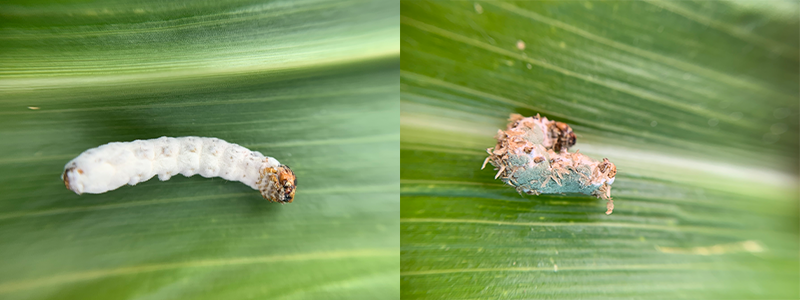In partnership with industry, staff at the Department of Agriculture and Fisheries are continuing their research to understand the pest status of this insect within our production systems and develop a range of sustainable practices (cultural, biological and chemical) to enable effective control.
On this page:
For information on FAW in horticulture, visit the DAF Engagement hub.
Monitoring and thresholds
While FAW has a wide host range, in Australian broadacre systems to date it has shown a marked preference for (both grain and forage crops) of maize, followed by sorghum.
Look for the egg masses and clusters of young larvae, and signs of leaf damage. Eggs are typically laid on the underside of lower leaves (particularly the cotyledons) in establishing crops. Check in the whorl and around the plant base for larvae.
Leaf damage will be visible long after larvae have finished their development. The condition of emerging leaves (damaged/undamaged) is a better indicator of an active infestation than damage to fully expanded leaves.
Thresholds under Australian conditions are currently unknown, and the development of clear management guidelines is the focus of current research.
Field experience in 2020-22 has shown that establishing maize/sweet corn/sorghum/grass crops are vulnerable to significant damage and possibly plant death if infested before the 4-leaf stage. It is essential that establishing crops be monitored at least weekly during this stage. In subtropical and temperate regions, spring-planted crops (September–October) have been less heavily infested than crops planted in summer (December–February). FAW populations build up locally through spring and summer, making later planted crops more likely to be infested.
Some examples of thresholds based on overseas data are listed below. These should be treated with caution, as some may be for Bt crop varieties not currently available in Australia:
| Crop | Threshold | Notes |
|---|---|---|
| Maize vegetative
Maize whorl stage |
3 or more larvae per plant *50% of plants with fresh feeding 20% of plants with one or more larvae *>75% of plants with feeding |
Based on US recommendations: *Purdue University: Need to consider economics of control i.e. $/ha to treat vs potential yield loss ($/ha). |
| Sweet corn Tassel emergence |
15% of infested plants | US recommendations: If necessary, control at tassel emergence is more effective than applications in the vegetative stages. |
| Sorghum vegetative
Sorghum grain fill |
30% defoliation, or >2 larvae per whorl Use the Beatsheet’s helicoverpa threshold calculator |
Based on US recommendations.
Damage at grain fill equivalent to helicoverpa. |
| Cotton | – | Monitor crops for leaf damage and fruiting site feeding. Bollgard 3 will incidentally suppress FAW. |
| Soybeans vegetative
Soybean budding-podding |
33% defoliation
3/m2 |
Based on S. litura (DAF) |
| Pasture (hay production only) | 2-3 larvae /sq foot | No permits currently. Armyworm outbreaks (other species) are not uncommon. |
Severe infestation are likely in the first few years of this incursion. This has been the pattern for other exotic species in recent years (e.g. silverleaf whitefly outbreak in CQ and solenopsis mealybug). As industries become more confident and experienced in managing this pest, and natural enemies start to suppress outbreaks, FAW is likely to become more easily managed in our farming systems.
Chemical use and resistance
Insecticide resistance has been a feature of FAW infestations with almost complete failure of all options in Brazil causing significant management issues. Insecticide resistance management of this pest, and the consideration of how its management will impact on resistance development in Helicoverpa armigera and other species is a key focus of research.
Various emergency permits have been secured to provide growers with chemical management options should control be required. See the APVMA permits portal (search for fall armyworm) for permits currently available. It is important to recognise that there are currently permits for some products that are largely ineffective in controlling Australian FAW populations. This is because FAW has developed resistance to a large number of modes of action (MOA) overseas, and the Australian populations carry the genes for some of these. Baseline screening of the Australian FAW populations in 2020-21 identified moderate resistance to carbamates and organophosphates and high resistance to synthetic pyrethroids (Bird et al. 2022#).
Ongoing monitoring of resistance levels and implementation of resistance management strategies will be essential to minimising the risk of resistance development in Australian FAW populations.
Natural enemies of FAW
Several predators, parasitoids and pathogens have been identified from FAW in Australia, including egg parasitoids (Trichogramma sp and Chelonus sp.), larval parasitoids (Cotesia sp, Tachinid flies), pupal parasitoids (Heteropelma sp.), predatory bugs, spiders and pathogens (Metarhizium rileyi).

FAW larva killed by Metarhizium rileyi. The fungus can be white (just hyphae) or green (sporulating).
Commercial formulations of FAW-specific nucleopolyhedrosis virus (Fawligen® and Spodovir® Plus) are available under permit for FAW control in a number of crops.
